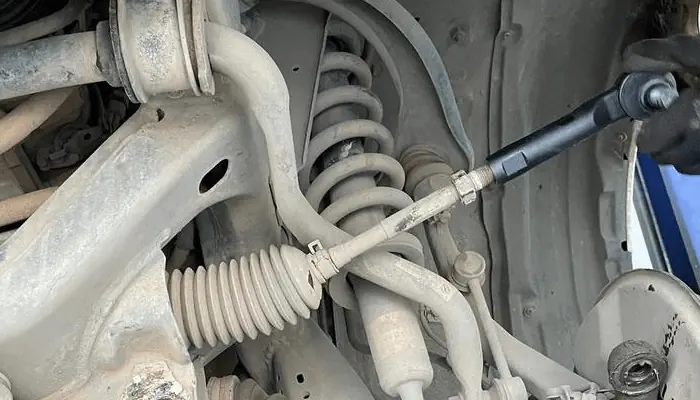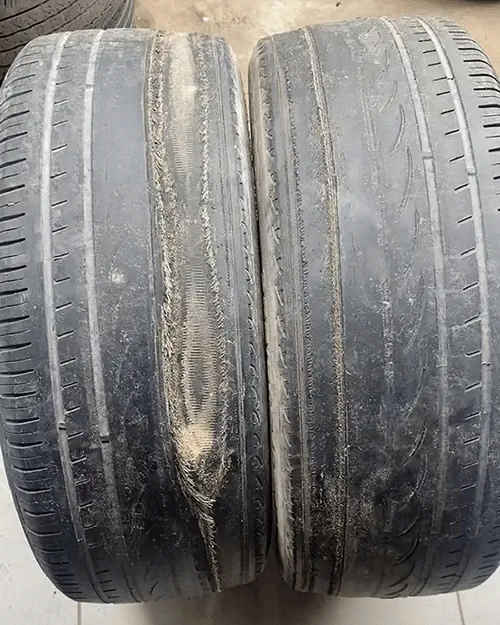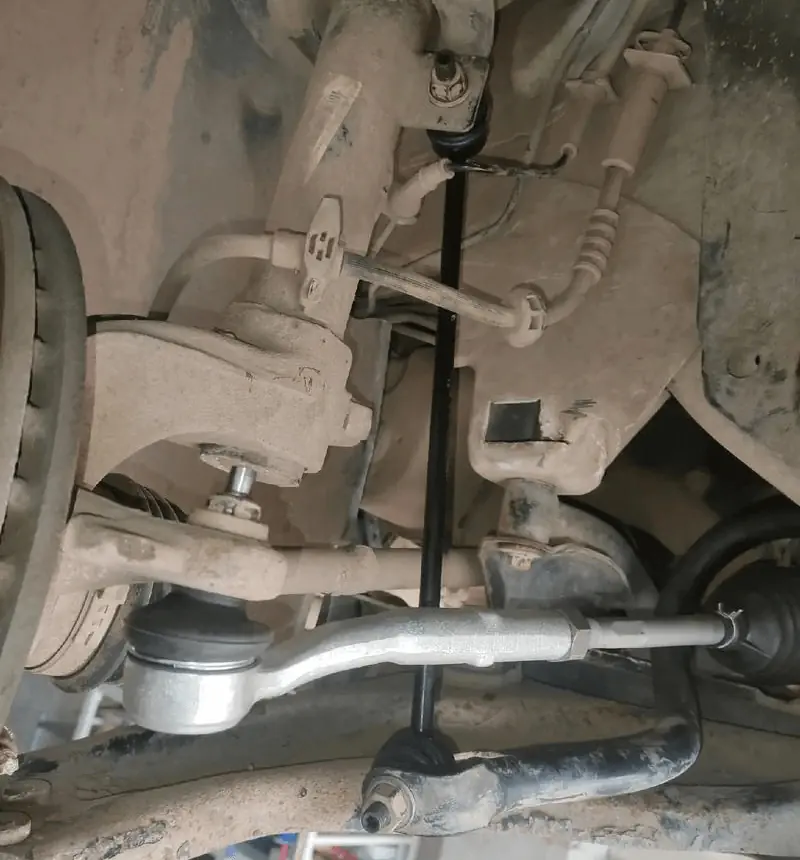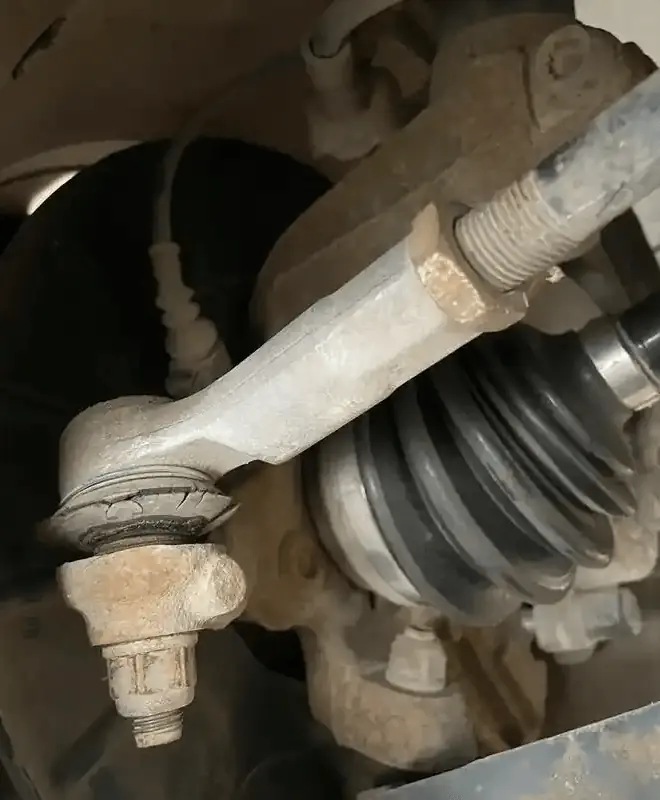What are Tie Rods
Steering relies on a sturdy tie rod to function properly. It connects the steering gear and the front wheels of the vehicle and can accurately transmit the steering action. Mechanics split the tie rod into two parts: the Inner Tie Rod (Rack End) and the Outer Tie Rod (Tie Rod End). When these inner vs outer tie rod components wear or loosen or damaged, the driving safety of the vehicle will be affected and it will not be able to steer normally.

Common Symptoms of a Bad Tie Rod (Signs of Bad Tie Rod)
-
1. Steering Wheel Vibration – Bad Tie Rod Symptom (can bad tie rods cause vibration?)
If when you are driving, you find that the steering wheel vibrates abnormally and the steering is unstable, it is very likely that the tie rod is damaged. Especially when driving at high speed, if the vehicle deviates from the driving direction or there is a delay in the steering wheel’s response. Due to the damage or loosening of the tie rod, the steering system could not remain stable, resulting in offset and abnormal vibration.
-
2. Clunking Noises When Turning – Signs of Worn Tie Rod (knock sound when turning steering wheel)
A broken tie rod often makes “creaking” or “thump thump” sounds. These abnormal noises are caused by the wear or loosening of the connecting parts of the tie rod. If you hear similar sounds, please check the steering system as soon as possible.
-
3. Vehicle Pulling to One Side – Tie Rod Failure Alert (tie rod symptoms)
While driving, you notice that the vehicle is shifting in a certain direction and you have to constantly straighten the steering wheel to maintain a straight line, it is very likely that there is a problem with the tie rod. A faulty tie rod can cause the wheels to fail to align, resulting in a shift and inability to drive stably in a straight line.
-
4. Loose or Stiff Steering – Tie Rod Damage Sign (how to tell if tie rod is bad)
A damaged tie rod can also cause the steering wheel to loosen or turn unsmoothly. If you feel that there is abnormal resistance or it is too easy when turning the steering wheel, there might be a problem with the tie rod.
-
5. Uneven Tire Wear – Classic Tie Rod Failure Evidence (uneven tire wear caused by bad tie rod)
If there is a problem with the tie rod, the Angle of the vehicle will also shift, causing abnormal wear of the tires, such as: the outer or inner side of the tire wears out too quickly. Regularly checking the wear of tires can also help detect early on whether the steering system is faulty.

-
6. Steering Drift During Acceleration (can a bad steering rack cause vibration?)
Steering drift refers to the situation where, when you release the steering wheel, the vehicle’s steering system still fails to return to its normal position, and the steering wheel either turns by itself or remains unstable. This problem is usually caused by the failure of the tie rod.
Detecting Whether the Tie Rod Is Damaged (How to Check for Bad Tie Rods ?)
-
1. Visual Inspection – How to Check Tie Rod Ends
Observe directly whether there is obvious wear, loosening or bending of the components connected by the tie rod. Check the connection points of the steering system to see if there are any abnormalities.
-
2. Steering Wheel Test – How to Tell If Tie Rod Is Bad
Gently turn the steering wheel and observe whether the vehicle’s steering system responds immediately. If the steering wheel turns slowly or has no response, it may indicate a problem with the tie rod.
-
3. Check Wheel Alignment – Signs of Bad Tie Rod
If you feel that the vehicle is veering off course or the tires are unevenly worn, it is very likely that the tie rods are not aligned properly. Regular four-wheel alignment checks on this vehicle can help detect vehicle problems in a timely manner.

How to Repair Broken Tie Rod? (Tie Rod Replacement Cost & Process)
No, The damaged tie rod cannot be repaired and can only be replaced with a new one in a timely manner. The replacement process requires professional vehicle maintenance personnel to complete.On average, tie rod replacement cost ranges from $100 to $200 per side.
The following are the basic steps for replacing tie rods:
- Lift the vehicle and remove the wheel: First, lift the vehicle and remove the tire to facilitate subsequent operations.
- Remove the old tie rod: Unscrew the nut at the tie rod connection and remove the old tie rod.
- Install the new tie rod: Install the new tie rod in place and tighten it according to the official torque.
- Four-wheel alignment: After the replacement is completed, perform the vehicle four-wheel alignment to ensure that the vehicle’s steering accuracy returns to normal.
Conclusion
The tie rod is one of the key components to ensure the safe driving of the vehicle. Regularly checking the steering system of the vehicle, especially the tie rod, can detect potential problems as early as possible and avoid traffic safety hazards caused by steering failure. If you find any bad situation with your vehicle, it is necessary to go to a professional repair shop for inspection and repair in time.
It is the responsibility of every vehicle owner to ensure the stability and safety of the vehicle by paying attention to the status of the tie rod. When encountering abnormal steering, do not ignore it. Solve it as soon as possible to avoid greater trouble.



